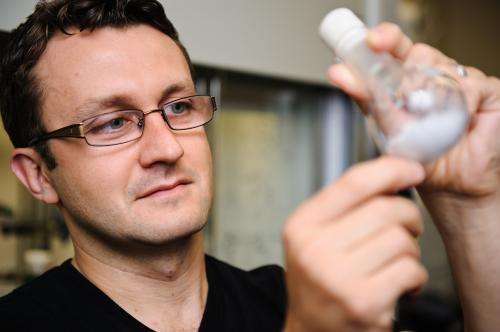Engineering professor granted patent for carbon-capture process

An innovative method for stripping greenhouse gases such as carbon dioxide from industrial emissions is potentially cheaper and more efficient than current methods, according to a United States patent based on research by Dr. Jason E. Bara, assistant professor of chemical and biological engineering at The University of Alabama.
Nearly all commercially-available efforts at scrubbing greenhouse gasses, GHG's, from emissions use a liquid solution of water and amine, derived from ammonia, that contacts the stream, removing carbon dioxide, CO2, or other unwanted gases. The system patented by Bara would replace much of the water in the aqueous amine solutions with a promising class of molecules known as imidazoles, organic solvents with a low vapor pressure, or boiling point.
The patent, granted earlier in August to UA, claims the chemical make-up of the imidazole-containing systems for use in capturing CO2 and other gases from natural gas and post-combustion emissions such as those from coal-fired power plants.
"The advantages of imidazoles in carbon capture are that they are a class of solvents with tunable chemical and physical properties," Bara said. "This gives us a lot of flexibility in designing a solvent system that can meet process demands."
There are global efforts to reduce the man-made emission of GHG's that likely contribute to global warming by trapping the sun's heat inside the atmosphere, including emission standards and financial penalties on excess emissions. The most common and most studied method is introducing monoethanolamine, or MEA, into natural gas or post-combustion emissions, a process that can capture about 90 percent of CO2 from flue gas.
The use of MEA to scrub flue gas is energy intensive since recycling the solution requires boiling it to desorb, or rid, the CO2 before recycle of the MEA solution back into contact with the flue gas. The cost of the energy needed to use MEA in power plants, for example, would likely be passed onto consumers, Bara said.
Bara's work shows that swapping most of the water in the process with imidazoles saves energy since the solvent can be regenerated without the energy penalties associated with boiling large amounts of water. Bara's research shows the solvent system can capture the same or more CO2than MEA.
The cost of capturing carbon is one reason the energy industry has been reluctant to embrace carbon capture on a large scale. "That's why it is important to look at solvents and materials that are tweaks to what are already established if we hope to do very large scale up over the next decade," Bara said.
"What's really nice about this solvent system is that we're not starting from scratch," he said. "Many imidazole cores are already commercially available, and through some very simple reactions, we can synthesize the molecules we want in the lab. This should bode well in terms of solvent cost if we were to scale them up."
This technology has been licensed to the clean tech company ION Engineering in Boulder, Colo., with the hope of further developing this technology for carbon dioxide capture. Bara helped found ION Engineering, and continues as a science adviser with the company.
Bara's research is funded by the U.S. Department of Energy, the National Science Foundation and the American Chemical Society Petroleum Research Fund.
Other patents based from Bara's work with imidazoles are pending. U.S. Patent Designated No. 8,506,914 was granted Aug. 13.
Provided by University of Alabama in Tuscaloosa

















